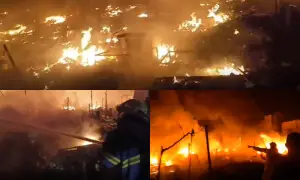Let’s talk climate justice, but first, Sindh should be honest with itself
‘He who seeks [climate justice] must do [climate justice]’ is a modification of a legal maxim of equity, which can help us understand Pakistan’s position and demand.
The monster monsoon of 2022, as Nazish Brohi called it, and subsequent disaster catapulted Pakistan to the forefront of the climate crisis negotiations at the 27th Conference of Parties (COP27) of the United Nations Framework Convention on Climate Change held November 6-20, 2022 at Sharm el-Sheikh, Egypt.
The increase in number and extremity of climate-induced events in states that have contributed less to climate change, led to a demand for climate justice. Sherry Rehman, federal minister for climate change, told a panel at the Pakistan Pavilion at COP27 that, “Delaying Climate Justice for the vulnerable is subjecting them to a death sentence”.
What is Climate Justice?
Climate Justice is a subset of the Environmental Justice movement that intends to highlight the disparate impact of climate change on vulnerable communities as well as promote a fair distribution of resources to address the impacts of climate change.
The ‘Environmental Justice’ movement emerged in the early 1980s in North Caroline, US. A decision by the state to host a toxic landfill sparked a wave of protests. The street protests and legal challenges mounted by the people of Warren County to fight the landfill are considered by many to be the first major milestone in the movement for environmental justice.
Environmental Justice, to put it simply, affirms the sacredness of Mother Earth, ecological unity and the interdependence of all species, and the right to be free from ecological destruction.
Climate Justice at home?
While advocating Climate Justice globally, we must ask if we are doing Climate Justice at home. To look for answers, we need look no further than Sindh, whose conditions are not much different from those of other provinces. Sindh’s is an obvious choice; it was one of the most affected provinces in the monster monsoon. Five months on its cities are still submerged. But let us set that aside for a moment and consider what else is happening in Sindh:
- The Sindh government held a jeep rally in a wildlife sanctuary in Tharparkar on January 4
- Bahria Town 2 in Karachi has been launched on part of Khirthar National park, and without fulfilling the mandatory requirement of submitting and obtaining an Environment Impact Assessment approval from the Sindh Environmental Protection Agency
- An expressway is being built in a riverbed in Karachi
- Sindh has not set up an Environmental Protection Council is not established in Sindh province
- New environmental assessment regulations are being made to take away many projects from public review
- In Thar, Malir, Kathore, Nooriabad, Mujhahid Colony and other parts, houses of marginal groups were demolished without providing alternate or compensation.
The monster monsoon can be attributed to climate change but the prolonged inundation of so many cities is linked to surface drainage designs and human management. This is bad governance and the outcome of decisions to encroach on waterways for projects—mostly roads without checking for environmental impact.
Many portions of the Indus highway in district Dadu had to be cut or breached to allow the floodwaters to drain away and prevent towns from being flooded. Bilawal Bhutto Zardari recently visited Dadu and shared photos of submerged towns.
Almost all projects, which are now said to have been poorly planned and turned a monsoon hazard into a disaster, had to carry out environmental assessments under the Environmental Protection law of Sindh. They were, however, either approved without assessments or approvals were granted without public participation.
A year before the monsoon, the Sindh government made major changes to the regulations that govern environmental checks and balances. As a result, many projects were hidden from public review. Public participation was no longer needed.
For instance, the people of an area had to be participate in the decision to build flood protection bunds. But under the new regulations, their participation is not required. The public is not needed any more to give its input on housing schemes constructed on less than 50 acres (240,000 square yards). You can change the category of a high rise building project from number of floors and square feet without providing any justification.
The environmental regime in Sindh province runs without a supervisory body: the Sindh Environmental Protection Council. The province’s law says it must set up a high-level council headed by the chief minister with the heads of all major departments (finance, irrigation, agriculture, local government, industries, education, public health engineering, health, forest and wildlife, energy and divisional commissioners as its members), and have 25 members from the chambers of commerce and industry, agriculture, industrial associations, medical and legal professionals, trade unions, NGOs concerned with the environment and sustainable development, scientists, technical experts and educationists. The council has to meet no less than twice a year.
The last time the council met was in 2016.
These are the few instances that will give you a sense of climate justice in one of the most affected provinces of the monsoon in Pakistan. Calling for Climate Justice globally would be a hollow slogan unless climate justice were done at home.
The writer is a lawyer and tweets at @zubair1878





















Comments are closed on this story.